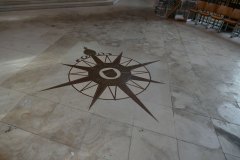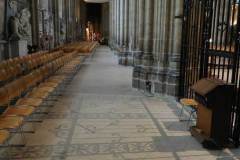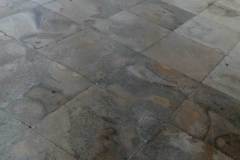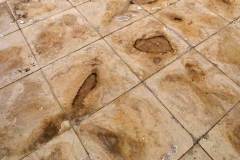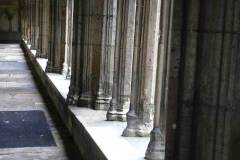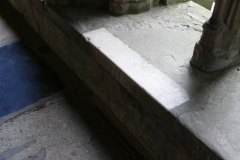Basics
Geology: oolitic and shelly limestone
Rock unit: Portland Stone Formation
Age: Upper Jurassic
Provenance: Isle of Portland, Dorset
Where to see examples
- round Compass Rose (image 1 below) and other parts of the nave floor (images 2-5). This was relaid after major archaeological work in 1993. The present floor is a mix of re-used older stones and (mainly in the south aisle) newer replacement stones.
- cloisters west walk (images 6 and 7 below)
Description
The Portland Stone quarries can be traced back to Roman times, although they came into their own in the seventeenth century with the advent of improvements in stone cutting technology and the re-building of London after the Great Fire of 1666. Until the twentieth century most workings were located close to the coast where stone could be loaded straight onto sea vessels, mostly small commercial barges. The modern quarries are often both deep and extensive. Portland Stone has become a prestigious building stone used in many famous London landmarks such as the British Museum, Somerset House and St. Paul’s Cathedral. It has also been used in most towns and cities throughout the country for important public buildings.
Three beds of Portland Stone are extensively worked and it is stone from the Base Bed, often considered the best quality stone, which is the probable source bed for Canterbury Cathedral. This bed provides a fine-grained, durable oolitic limestone with negligible shell content. The stone is grey-white or cream-coloured on fresh exposure but will weather to a characteristic white and has good resistance to atmospheric pollution. However, its harsh white appearance, especially when newly laid, was not always welcomed. Robert Willis, commenting in the nineteenth century on the restoration work to St. Anselm’s Tower and Chapel, is reported as saying “mouldings were very badly wrought, which, with the unfortunate colour and surface of the Portland stone, has given the window a most ungenuine air”.
Portland Stone continued to be used at Canterbury Cathedral at various times during the eighteenth, nineteenth and twentieth centuries and following the Second World War The Bath and Portland Stones Firm Limited supplied the Dean and Chapter with their namesake stone.
Repairs to the stonework at the foot of the cloister columns have been made with Portland Stone. They are easy to spot as the stone is whiter and more smooth than the remainder of the ledge. The example above is in the west walk – there are several others elsewhere in the cloisters.

